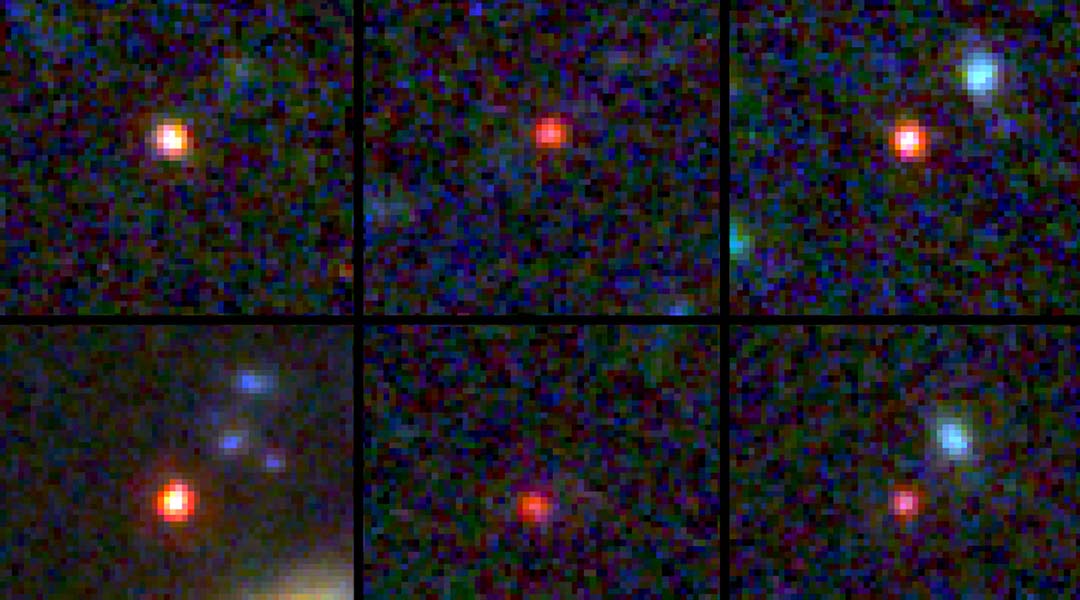Launched into orbit in late 2021, the James Webb Space Telescope is the most powerful space observatory ever built. Although it has been in operation for a little over a year, scientists have already made important observations with it and obtained very detailed images of some of the most interesting objects in space, from exoplanets to the interior of the Pillars of Creation.
But perhaps the most important discovery made with this telescope to date is the recent observation of six very massive galaxies that, according to our current understanding of the Universe, should not exist at all.
Universe breakers
In a study published in Nature, an international team of researchers reported the detection of light emitted by these galaxies about 13 billion years ago, or to be more precise, 500 to 700 million years after the Big Bang.
The age of the galaxies was determined from the redshift of their radiation — a phenomenon in which the length of electromagnetic waves increases along with the expansion of the Universe, similar to the Doppler effect. Comparing the light wavelengths with what they expected from the radiation of real galaxies allows astronomers to figure out how long the light took to travel to get to Earth and hence how old the object it emitted is.
By analyzing the light intensity and spectrum, the scientists were able to deduce the masses of the galaxies and concluded that they are almost as large as our own Milky Way. This contradicts modern cosmology, which claims that such massive galaxies should not have formed during the early stages of the evolution of the Universe. This is because the formation of galaxies after the Big Bang is believed to take a long time, and those few hundreds of millions of years definitely should not have been enough.
“It’s bananas,” said Erica Nelson, assistant professor of astrophysics at CU Boulder and one of the authors of the study, in a press release. “You just don’t expect the early Universe to be able to organize itself that quickly. These galaxies should not have had time to form.”
In order for such large galaxies to form so quickly, the rate of star formation in them must have been orders of magnitude higher than what scientists expected.
“The Milky Way forms about one to two new stars every year,” explained Nelson. “Some of these galaxies would have to be forming hundreds of new stars a year for the entire history of the Universe.”
What this means for cosmology
These findings contradict not only theoretical ideas, but also the data collected by other well-known space observatories, such as the Hubble and Spitzer telescopes, which have previously observed galaxies of about the same age, but much less massive.
If true, these results will turn our understanding of the origin and evolution of the Universe on its head. However, the researchers note that in order to confidently declare such a sensational discovery defying the whole modern cosmological theory, further observations and data analysis are needed.
It is possible that their assumptions about the structure of galaxies and the details of their radiation spectrum are incorrect, and in reality, these galaxies are much lighter than the preliminary study suggests, which will make their masses consistent with theoretical understanding.
One other possible explanation for the contradiction is that these galaxies are not what scientists think they are, but new objects that would still be consistent with modern cosmological theory.
“Another possibility is that these things are a different kind of weird object, such as faint quasars, which would be just as interesting,” explained Nelson.
Whatever these objects are, further research is likely to have a very serious impact on our theories of the evolution of stars, galaxies, and perhaps the Universe as a whole, requiring a significant change in understanding of the processes occurring shortly after the Big Bang.
“If even one of these galaxies is real, it will push against the limits of our understanding of cosmology,” concluded Nelson.
Reference: Ivo Labbé et al., A population of red candidate massive galaxies ~ 600 Myr after the Big Ban, Nature (2023). DOI: 10.1038/s41586-023-05786-2.
Feature image: Images of six candidate massive galaxies, seen 500-700 million years after the Big Bang. One of the sources (bottom left) could contain as many stars as our present-day Milky Way, but is 30 times more compact. Image credit: NASA / ESA / CSA / I. Labbe, Swinburne University of Technology / G. Brammer, Niels Bohr Institute’s Cosmic Dawn Center, University of Copenhagen.

















